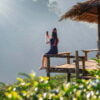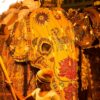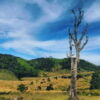Ancient city of Sigiriya
This capital city was built by King Kassapa I (477-95) and is located majestically at the zenith of a granite peak 180m high (Sigiriya Lion’s Rock Fortress). This is basically an enormous rock in the middle of the jungle, and it is visible from a very long distance as you approach Sigiriya. Even the entrance to this royal “fortress” is the large open mouth of a lion and the staircases & galleries that you pass are truly marvelous.

Sacred city of Anuradhapura
This is a truly sacred city because it was built around a cutting that was derived from the tree beneath which Lord Buddha attained enlightenment. The cutting was brought to Anuradhapura in the third century B.C. This city flourished as the capital for 1,300 years, but the city was abandoned due to an invasion in 993, and the city got covered by the jungle. But now this ancient city has been cleared for viewing purposes and its monuments, monasteries, & palaces are sure to leave you stunned.

Ancient city of Polonnaruwa
After the collapse of Anuradhapura in 993, Polonnaruwa became the second capital of Sri Lanka. Polonnaruwa is today famous for the ruins of the astounding garden-city built by Parakramabahu I in the 12th century. The Brahmanic monuments of the Cholas, dictate much of the ruins that you will see in this city.

Dambulla rock cave temple
This golden rock temple is the largest cave temple in Sri Lanka, consisting of 5 sanctuaries. For twenty-two years, this temple has been a sacred pilgrimage site. The 157 different Buddha statues and the Buddhist mural paintings are absolutely beautiful.

Hill capital of Kandy
This was the last capital of the Sinhala kings for more than 2,500 years. Afterwards the British took over in 1815. Kandy is also home to the famous Temple of the Tooth Relic which houses the sacred tooth of Lord Buddha.

Dutch fort of Galle
The Portuguese found Galle in the 16th century, and it was conquered by the British in the 18th century. South Asian and European architecture, tradition & culture come together to make this fortified city a one-of-a-kind place in Asia. Coral & Granite are symbolic in many of the structures, and the wide streets are lined with classy plants and houses with private gardens & verandas. In 1344 it was the main port of Ceylon (Sri Lanka was known as Ceylon back then).








 Among the Top 10 Inbound Travel Agencies
Among the Top 10 Inbound Travel Agencies  Tourist Board license
Tourist Board license  10 Years of Service
10 Years of Service  2000 Happy Clients
2000 Happy Clients  A Prestigious Partner of Viator
A Prestigious Partner of Viator